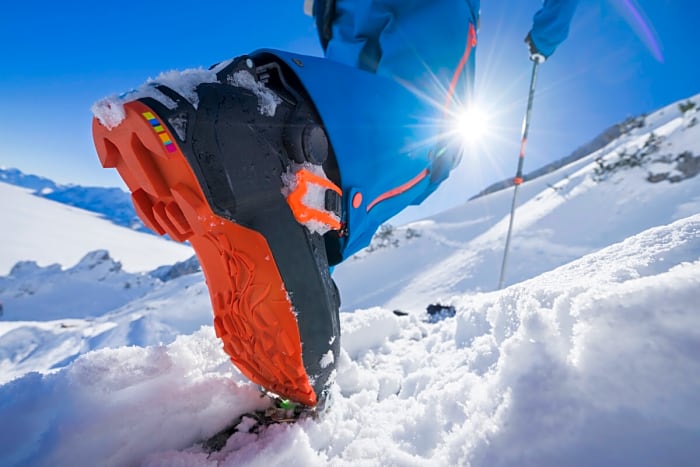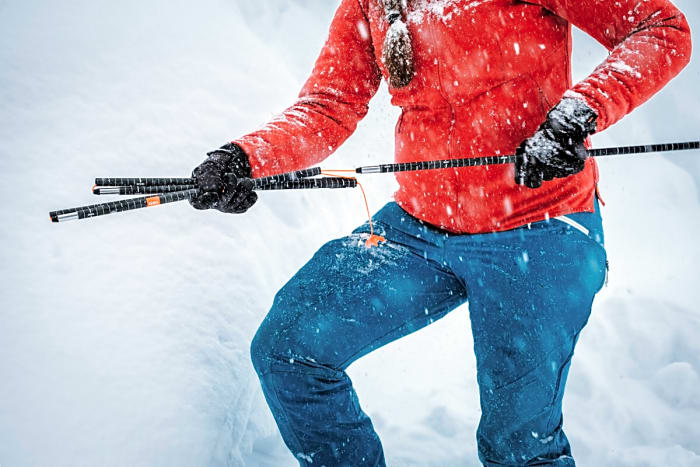
Ski touring is skiing uphill and then—here’s the best part—skiing back downhill. Thanks to specialized equipment, participants can use their skis to “walk” up the mountain, even on surprisingly steep slopes.
You may have seen their ilk at a ski resort, plodding slowly along the edge of groomed runs. “Skins” attached to the bottom of their skis are what prevent them from sliding backwards downhill. Flexible boots and bindings allow for the walking motion they use. But we’ll talk more about the gear specifics later.
Keep reading for a quick and dirty primer on ski touring.
Want to keep up with the best stories and photos in skiing? Subscribe to the new Powder To The People newsletter for weekly updates.
Where To Go Ski Touring
In North America, the bulk of ski touring happens outside the boundaries of ski resorts in the backcountry on some form of public land. It could involve gentle glades, steep peaks, or some combination of both. Ski touring is a workout, and avalanches are a danger in the backcountry, but climbing uphill doesn’t have to involve gnarly skiing. You can just go bounce around in the woods for a few hours.
Given ski touring’s close association with backcountry skiing, the terms are often used interchangeably. But at some ski resorts, you can also go on a ski tour within the resort boundary. Policies differ from mountain to mountain. Some allow ski touring before the lifts open and after they close. Others have specific trails designated for ski tourers.
The main benefit of ski touring at ski resorts is that it almost completely eliminates the risk of avalanches. This way, skiers can get in a workout—or learn the fundamentals of uphill travel—without worrying about the technicalities of traveling through avalanche terrain.

Why Do People Go Ski Touring?
Haven’t any of these touring enthusiasts heard of chairlifts? Of course. There are, however, several valid reasons to earn your turns:
- Fewer crowds: Some backcountry areas have gotten busier, but if you know where to look, it isn’t too hard to find a quiet, forested zone where you can ski without the crowds. It’s just you, the trees, and the snow—no lift lines or waiting for 40 minutes to buy an overpriced lodge burger.
- It’s a great workout: Even if they’re light, hauling a pair of skis uphill isn’t easy. Ski touring is a notoriously tough cardio workout, so many opt for the skin track because they want to sweat.
- Better snow (sometimes): This one’s a bit of a crapshoot. When the snow’s good outside the ski resort, it’s really good. With fewer people taking laps, moguls and cut-up mank are usually nonexistent. But there’s a catch. There aren’t grooming machines that smooth out inconsistencies in the snow in the backcountry, so when the conditions are bad, they’re awful.
Do I Need To Be in Good Shape to Ski Tour?
Short answer: yes. Long answer: kind of. Ski touring is harder than hiking. If you go straight from the couch to the skintrack, you’ll probably end up surprising yourself with how out of shape you are—unless you’re a gifted cardio athlete.
So, those with plans to begin ski touring should start training before winter starts. Go on long runs. Find some lower-body workouts you enjoy. I’ve had success with running up and down long flights of stairs. The important thing is that you stay moving during the offseason.

What Equipment Do You Need to Ski Tour?
Touring is the most equipment-intensive form of skiing. To get started, you’ll need the following pieces of equipment (keep reading for an additional section about avalanche gear):
Touring bindings: Most but not all forms of ski touring bindings include two pins in the toe piece. These pins latch onto the front of your boots, locking them into place. They also facilitate “walk mode,” allowing the boot to pivot freely as you slide uphill.
There are several types of touring bindings, but they usually fall into one of three categories: tech, hybrid, and frame. Tech (or pin) bindings are stripped down and lightweight. Hybrid bindings cover the middle ground, ideally offering the best of both worlds. Frames are a standard alpine binding on a heavy, mobile plate.
Touring ski boots: Touring ski boots, like their binding counterparts, also have a “walk mode.” Usually, it’s activated by a lever in the back of the boot, offering a greater range of motion during the uphill portion of a day in the backcountry. Touring boots also have tech inserts—two little holes that correspond with the prongs on touring bindings.
Skins: Without skins, you won’t be going anywhere except downhill. These pieces of material, usually made from mohair or nylon, attach to the bottom of the skis with re-usable glue. They allow some sliding in a forward direction, but are grippy enough to ensure you can climb up the mountain with your skis.
Touring skis: Touring skis aren’t that different from traditional alpine skis. In most cases, they just weigh less, making climbing not as tiring. They aren’t mandatory, either. Some skiers forego touring skis altogether, choosing alpine models for the downhill performance benefits. Because they’re light, touring skis can feel unstable.
A backpack: You're going to want a place to store your gear. Some touring-specific backpacks have slots for avalanche equipment alongside other features catered to backcountry skiers.
Beyond these basics, you'll need everything else you usually use to go skiing, like a helmet, goggles, and a jacket. And snacks. You can't forget the snacks.

Is Ski Touring Dangerous?
I don’t write this to scare you, but between 20 and 30 people die in avalanches each year on average in the U.S. On more difficult ski tours in bigger mountains, risks like rockfall, tree wells, and crevasses are worth considering, too. So, yes, ski touring can be dangerous. Anyone planning to spend time in the backcountry needs to learn the fundamentals of safely moving through avalanche terrain. That’s a prerequisite, not a suggestion.
However, there are ways to mitigate risk. Loads of skiers go on casual, low-risk ski tours each winter. Touring doesn't need to involve a dramatic, life-threatening journey through the mountains. To do this, though, you have to know how avalanches work. We’ll defer to the experts on this one.
Entry-level avalanche courses offered by groups like the American Institute for Avalanche Research and Education (AIARE) cover the basics, like identifying avalanche terrain and executing a companion rescue. Books offer an opportunity to learn, too. Staying Alive in Avalanche Terrain is a beautifully written, must-read for anyone with a growing interest in ski touring.

Is Avalanche Equipment Necessary?
Almost any avid backcountry skier will tell you that the answer to this question is yes. Well, most of the time—there are unique circumstances where some experts might leave their beacon at home. For the general backcountry population, though, the holy trinity of avalanche equipment is mandatory.
Here’s what you should bring:
Avalanche beacon: These fancy gizmos have two modes: “transmit” and “search” mode. Most of the time, you’ll use the former. In this mode, the beacon emits radio signals that can be tracked by other beacons, so if you get buried in the snow, your friends or rescuers can find you. They would do so using “search” mode.
Shovel: This is self-explanatory. If someone is buried in an avalanche, they’ll need to be dug out. Numerous brands make lightweight shovels designed for backcountry skiing use.
Probe: Oftentimes, after an avalanche, victims are buried beneath several feet of snow. That’s where probes come in. Once a rescuer thinks they’re at the site of the burial, they’ll plunge their probe into the snow, hoping to hit the victim. If they do, it’s time to dig. Probes are long, skinny, collapsible metal rods that fit neatly into backpacks.
More must-reads:
- Braves making managerial change after 10 seasons under Brian Snitker
- MLB playoff takeaways: Skubal pitches gem; Yankees failed by unexpected source
- The 'Last 100-yard rusher by NFL team' quiz
Breaking News
Trending News
Customize Your Newsletter
 +
+
Get the latest news and rumors, customized to your favorite sports and teams. Emailed daily. Always free!








